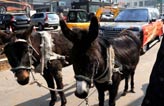Foreign and Military Affairs
Full text: China's National Defense in 2010
Updated: 2011-03-31 11:31
(Xinhua)
IV. Deployment of the Armed Forces
Adapting to changes both in times and security environment, the Chinese armed forces take an active role in dealing with various security threats, safeguard national security and development interests, and play an important role in maintaining world peace and promoting common development.
Safeguarding Border, Coastal and Territorial Air Security
China practices an administration system of sharing responsibilities between the military and the local authorities in border and coastal defense. The armed forces are mainly tasked to safeguard the border, coastal and maritime security, and guard against, stop and subdue such activities as foreign intrusions, encroachments, provocations and cross-border sabotage. The main responsibilities of the border public security force are as follows: border, coastal and maritime public security administration, entry-exit frontier inspection at ports; prevention and crackdown on illegal and criminal acts in border and coastal areas, such as illegal border crossing, drug trafficking and smuggling; and organization of and participation in counter-terrorist and emergency-management operations in border and coastal areas. Organs of maritime surveillance, fisheries administration, marine affairs, inspection and quarantine, and customs are responsible for ensuring legitimate rights, law enforcement, and administration. The State Commission of Border and Coastal Defense, under the dual leadership of the State Council and the Central Military Commission (CMC), coordinates China's border and coastal defenses. All military area commands, as well as border and coastal provinces, cities and counties, have commissions to coordinate border and coastal defenses within their respective jurisdictions.
In recent years, in line with the policy of consolidating border defense, cultivating good neighborliness and friendship, maintaining stability and promoting development, the PLA frontier and coastal guards abide by relevant laws and regulations of China as well as any treaties and agreements with neighboring countries, well perform border defense duties, maintain a rigorous guard against any invasion, encroachment or cross-border sabotage, timely prevent any violation of border and coastal policies, laws and regulations and changes to the current borderlines, and effectively safeguard the security and stability of the borders, coastal areas and maritime waters within their jurisdictions. The border public security force makes solid progress in border defense and control, counter-terrorism, and maintenance of stability. It has strengthened efforts in port inspection, maritime management and control, and clampdown on crimes, including illegal border crossing, drug-trafficking and smuggling. Since 2009, it has solved 37,000 cases and confiscated 3,845 illegal guns.
China has always treated combined military, police and civilian efforts as a strong guarantee for consolidating border and coastal defenses and developing border and coastal areas. In recent years, China has steadily improved a border and coastal defense force system featuring the PLA as the mainstay, the coordination and cooperation of other relevant forces, and the extensive participation of the militia, the reserve forces and the people in the border and coastal areas. It has advanced the informationization of border and coastal defenses, taking the command system as the focus and information infrastructure as the support, and strengthened efforts in building border and coastal defense infrastructure. This has enhanced border and maritime control capabilities and promoted the economic construction and social stability in the border and coastal areas.
Territorial air security is an important constituent of overall national security. The PLAAF is the mainstay of national territorial air defense, and in accordance with the instructions of the CMC, the Army, Navy, and People's Armed Police Force (PAPF) all undertake some territorial air defense responsibilities. The PLAAF exercises unified command over all air defense components in accordance with the CMC's intent. China's territorial air defense system stands on permanent alert. It keeps track of any developments in the air, preserves air traffic order, organizes combat air patrols, handles air emergencies, and resolutely defends China's sovereignty over its territorial air and its air security.
Maintaining Social Stability
In accordance with relevant laws and regulations, and mainly under the unified leadership of local Party committees and governments, the armed forces of China assist the public security forces in maintaining social order and ensure that the people live and work in peace and stability.
The PAPF is the state's backbone and shock force in handling public emergencies. Since 2009, it has handled 24 acts of serious violence and crime, including hostage taking, participated in 201 operations of hunting down criminal suspects, and fulfilled the task of security provision during the celebrations of the 60th anniversary of the founding of the People's Republic of China, the Shanghai World Expo, and the Guangzhou Asian Games.
In November 2010, the CMC approved and promulgated Regulations on Emergency Command in Handling Emergencies by the Armed Forces, which specifies for the armed forces regulations concerning their organization, command, force deployment, integrated support, and civil-military coordination while carrying out missions to maintain social stability and handle emergencies.
Participating in National Construction, Emergency Rescue and Disaster Relief
As stipulated by the Constitution and laws, an important task for the armed forces is to take part in national construction, emergency rescue, and disaster relief.
The PLA and PAPF have actively participated in and supported national construction work, of which a key component is the large-scale development of the western region. In the past two years, they have contributed more than 16 million workdays and utilized 1.3 million motor vehicles and machines, and participated in construction of more than 600 major infrastructure projects relating to transportation, hydropower, communications and energy. They have set up more than 3,500 contact points for rural poverty alleviation, and provided assistance to over 8,000 small public initiatives, such as water-saving irrigation projects, drinking water projects for both people and livestock, road construction projects, and hydropower projects. The armed forces stationed in the western region have planted 11 million trees and afforested 3.2 million mu of barren hills and desert land by large-scale forestation and aerial planting. PLA medical and health units have provided assistance to 130 county-level hospitals in poverty-stricken western areas, sent there 351 medical teams and donated 110 sets (items) of instruments and equipment. With donations, the armed forces have financed and built eight schools and one rehabilitation center in earthquake-stricken areas in Sichuan, Shaanxi and Gansu provinces.
The armed forces of China act as the shock force in emergency rescue and disaster relief. In January 2009, with the armed forces as the mainstay, China formed eight state-level emergency-response professional units, boasting a total of 50,000 personnel, specializing in flood control and emergency rescue, earthquake rescue, nuclear, biological and chemical emergency rescue, urgent air transportation, rapid road repair, maritime emergency search and rescue, emergency mobile communication support, and medical aid and epidemic prevention. In July 2009, China integrated the 31,000-strong PAPF protecting water and electricity supplies and communications into the national emergency rescue system. Provincial level units specializing in emergency rescue have been formed with the joint participation of military area commands and relevant provinces, autonomous regions, or municipalities directly under the central government.
In the past two years, the PLA and PAPF have engaged a total of 1.845 million troop deployments and 790,000 deployments of vehicles or machines of various types, flown over 181 sorties (including the use of helicopters), organized 6.43 million militiamen and reservists, participated in disaster relief operations in cases of floods, earthquakes, droughts, typhoons and forest fires, rescued or evacuated a total of 1.742 million people, rush-transported 303,000 tons of goods, dredged 3,742 km of waterways, dug 4,443 wells, fortified 728 km of dikes and dams, and delivered 504,000 tons of domestic water.
Participating in UN Peacekeeping Operations
As a responsible major power, China has consistently supported and actively participated in the UN peacekeeping operations, making a positive contribution to world peace
In 1990, the PLA sent five military observers to the UN Truce Supervision Organization (UNTSO) - the first time China had taken part in UN peacekeeping operations. In 1992, it dispatched an engineering corps of 400 officers and men to the UN Transitional Authority in Cambodia (UNTAC) - the first time China had sent an organic unit on peacekeeping missions. It established the Peacekeeping Affairs Office of the Ministry of National Defense of the People's Republic of China in 2001. In 2002, it joined the UN Stand-by Arrangement System. In 2009, it established the Peacekeeping Center of the Ministry of National Defense of the People's Republic of China. As of December 2010, China has dispatched 17,390 military personnel to 19 UN peace-keeping missions. Nine officers and men have lost their lives on duty.
Tough, brave and devoted, the Chinese peacekeeping troops have fulfilled various tasks entrusted to them by the UN in a responsible and professional way. They have built and repaired over 8,700 km of roads and 270 bridges, cleared over 8,900 mines and various explosive devices, transported over 600,000 tons of cargo across a total distance of 9.3 million km, and treated 79,000 patients.
As of December 2010, the PLA had 1,955 officers and men serving in nine UN mission areas. China has dispatched more peacekeeping personnel than any other permanent member of the UN Security Council. Among these are 94 military observers and staff officers; 175 engineering troops and 43 medical personnel for the United Nations Organization Mission in the Democratic Republic of the Congo (UNMONUC); 275 engineering troops, 240 transportation troops and 43 medical personnel for the United Nations Mission in Liberia (UNMIL); 275 engineering troops and 60 medical personnel for the United Nations Interim Force in Lebanon (UNIFIL); 275 engineering troops, 100 transportation troops and 60 medical personnel for the United Nations Mission in Sudan (UNMIS); and 315 engineering troops for the African Union/United Nations Hybrid Operation in Darfur (UNAMID).
Conducting Escort Operations in the Gulf of Aden and Waters off Somalia
In line with relevant UN resolutions, China dispatched naval ships to conduct escort operations in the Gulf of Aden and waters off Somalia on December 26, 2008. They are mainly charged with safeguarding the security of Chinese ships and personnel passing through the Gulf of Aden and Somali waters, and the security of ships delivering humanitarian supplies for the World Food Program and other international organizations, and shelter pass-by foreign vessels as much as possible. As of December 2010, the Chinese Navy has dispatched, in seven sorties, 18 ship deployments, 16 helicopters, and 490 Special Operation Force (SOF) soldiers on escort missions. Through accompanying escort, area patrol, and onboard escort, the Chinese Navy has provided protection for 3,139 ships sailing under Chinese and foreign flags, rescued 29 ships from pirate attacks, and recovered nine ships released from captivity.
China takes a proactive and open attitude toward international escort cooperation. Chinese escort fleets have established mechanisms for regular intelligence exchange and sharing with relevant countries and organizations. It has exchanged 24 boarding visits of commanders with fleets from the EU, the multinational naval force, NATO, Russia, the ROK, the Netherlands and Japan. It has conducted joint escort operations with Russian fleets and joint maritime exercises with ROK escort ships, and exchanged officers for onboard observations with Dutch fleets. China has joined international regimes such as the UN liaison groups' meeting on Somali pirates, and the international conference on "intelligence sharing and conflict prevention" escort cooperation. Holding Joint Military Exercises and Training with Other Countries
In adherence to the principles of being non-aligned, non- confrontational, and not directed against any third party, the PLA has held joint exercises and training with other countries pursuant to the guidelines of mutual benefit, equality and reciprocity. As of December 2010, the PLA has held 44 joint military and training exercises with foreign troops. This is conducive to promoting mutual trust and cooperation, drawing on useful lessons, and accelerating the PLA's modernization.
Joint counter-terrorism military exercises within the SCO framework are being institutionalized. In 2002, China ran a joint counter-terrorism military exercise with Kyrgyzstan, the first ever with a foreign country. In 2003, China ran a multilateral joint counter-terrorism military exercise with other SCO members, again the first ever with foreign countries. In 2006, China and Tajikistan ran a joint counter-terrorism military exercise. China and Russia as well as other SCO members ran a series of "Peace Mission" joint counter-terrorism military exercises in 2005, 2007, 2009 and 2010.
Maritime joint exercises have been held on a regular basis. In 2003, China ran a joint maritime search-and-rescue exercise with Pakistan, the first ever between China and a foreign country. During mutual port calls and other activities, the PLAN has run bilateral or multilateral joint maritime exercises with the navies of India, France, the UK, Australia, Thailand, the US, Russia, Japan, New Zealand and Vietnam, focusing on tasks such as search-and-rescue, communication, formation sailing, diving, and escorting. In 2007 and 2009, the PLAN participated in multilateral joint maritime exercises organized by the Pakistani navy. In 2007, the PLAN took part in the joint maritime exercise held in Singaporean waters within the framework of the Western Pacific Naval Symposium. In 2010, China held a joint marine training with Thailand, the first ever between China and a foreign country.
Extensive joint military training on land has been carried out. China held a joint army training with Thailand in 2007, the first ever with a foreign country. In recent years, China has conducted joint military training with many countries, including Pakistan, India, Singapore, Mongolia, Romania and Thailand, focusing on tasks such as counter-terrorism, security and safeguarding, peacekeeping, and mountain and amphibious operations, all directed towards exploring new models of mixed grouping and joint training. In 2009, for the first time, China sent a medical detachment to Africa to hold a joint operation with Gabon, to conduct medical training and rescue exercises, and to provide medical assistance for local residents. In 2010, China sent a medical team to Peru for joint training on humanitarian medical aid and emergency medical rescue, in an effort to improve its capabilities in responding to humanitarian emergencies.
Participating in International Disaster Relief Operations
China's armed forces consider it an obligation to take part in international disaster relief operations organized by the government, and to fulfill international humanitarian obligations. In recent years, they have actively assisted relevant departments of the Chinese government to provide relief materials to disaster-stricken countries and to contribute specialized teams to international disaster relief operations.
Since the PLA provided relief supplies to Afghanistan in 2002, it has carried out 28 urgent international humanitarian aid missions, and provided 22 disaster-stricken countries with relief materials including tents, blankets, medicine, medical appliances, food and generators. The total value exceeds RMB950 million. In 2001, the Chinese International Search and Rescue (CISAR) team, consisting of officers and men from an engineer regiment of the Beijing Military Area Command, medical care personnel from the PAPF General Hospital, and experts from the China Earthquake Administration, began to participate in international disaster relief operations. CISAR has since carried out eight rescue operations in disaster-stricken countries. In January 2010, the CISAR team and the PLA medical care and epidemic prevention team were sent to Haiti to conduct earthquake rescue, post-earthquake search and relief, medical work and epidemic prevention operations. They rescued and treated 6,500 sick and injured. In September 2010, the CISAR team, a PLA medical team and a helicopter rescue formation were sent to Pakistan to conduct humanitarian rescue operations, with the saving and treatment reaching 34,000 person-times in total and 60 tons of airdropped goods and materials.
The Chinese armed forces have played an active role in international exchanges and cooperation in disaster relief, engaging in close communication and coordination with relevant countries and international organizations, and promoting the perfection of procedures and the training of personnel for regional disaster relief. They have held seminars and joint operations on humanitarian rescue and disaster limitation with armed forces of the US, Australia and New Zealand, run the ASEAN Regional Forum workshop on formulating legal rules for armed forces' participation in international disaster relief operations, and attended the ASEAN Plus Three workshop on armed forces' participation in international disaster relief.
E-paper

Rise and shine
The Chinese solar energy industry is heating up following recent setbacks in the nuclear sector
Preview of the coming issue
Bombs aim for regime change
CSI, with a twist
Specials

Donkey-powered Land Rover
Two donkeys pull a broken-down Land Rover in Shenyang, Liaoning province.

China Fashion Week
Models present creations for the Hosa Swimwear Trend Press Conference 2011.

Peony express
Growers of china's unofficial national flower are reaching out to europe for help
